PDF Attached
Multi
month highs were seen for many CBOT ag contract months. Soybean oil was limit lower and limits expand 50 percent (along with complex).
https://www.cmegroup.com/trading/price-limits.html
EPA released mandates for 2023-2025 and traders viewed the advanced biofuel as less than expected (modest increase). Some traders were looking for a 5-7% increase for advanced from the December proposal of 5.82 billion gallons. US crush margins were down sharply.
A decline in spring wheat, corn and soybean conditions underpinned those markets. Careful of the sharp increase in some of these markets. Prices tend to fall faster when fundamentals change.
FI
crop year average update.
We took SBO for 2022-23 down about 300 points, raised meal by $5, and soybeans adjusted higher by about 25 cents. 2023-24 raised corn and soybean averages by about 25 and 15 cents, respectively, and left wheat unchanged. Adjusted new crop SBO lower and meal
about unchanged from previous. This can and will easily change as we move deeper into the summer growing season. See below.
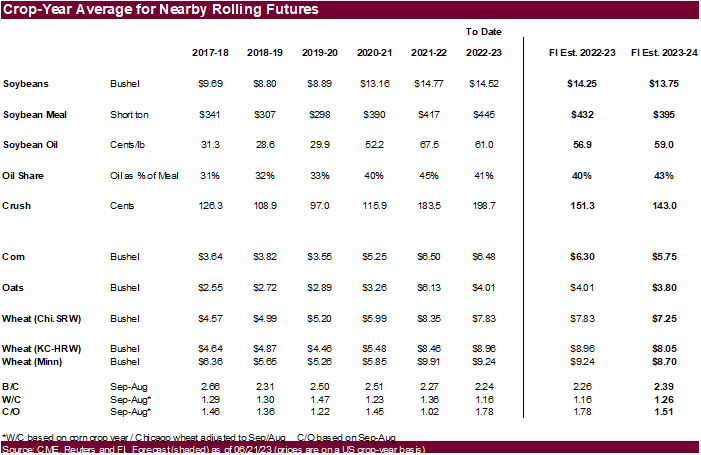
Today
is the official start of NA summer. US weather looks good for US wheat (PNW still dry) bias Great Plains and parts of the WCB for summer crops. It will be wet for the far ECB while the heart of the US will see net drying. The southeastern US will see rain
through Friday and northeast areas this weekend. The central and northwestern areas have a chance for rain late this week.
US
EPA mandates:

Fund
estimates as of June 21 (net in 000)
![]()
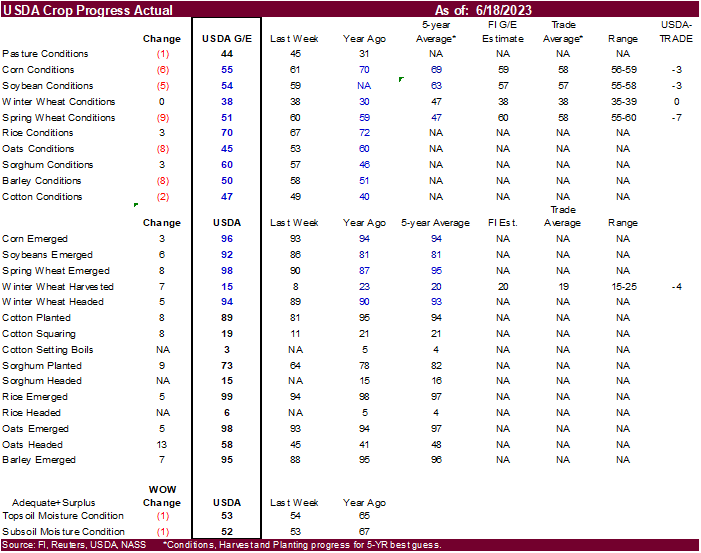
The
lack of rain for the Midwest is not only impacting early US crop conditions, but other industries as well. Miss. River water levels are low for this time of year. Other parts of the world are feeling the strain. The Panama Canal area is seeing its driest season
in more than a century. https://maritime-executive.com/article/panama-canal-further-restricts-drafts-due-to-falling-water-levels
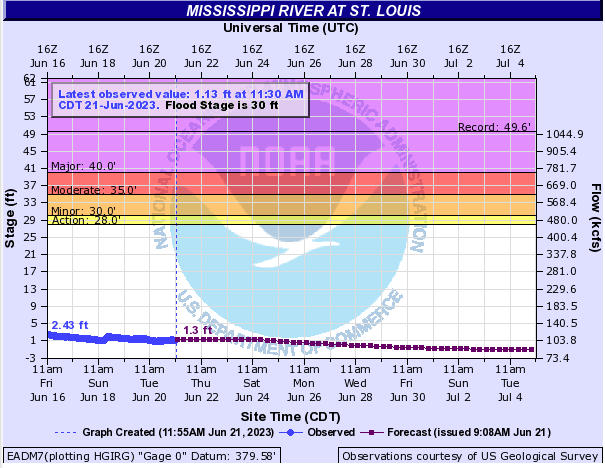
University
of Illinois: Dry Weather and Drought in the Midwest, Middle-June 2023
Schnitkey,
G., N. Paulson, C. Zulauf and J. Baltz. “Dry Weather and Drought in the Midwest, Middle-June 2023.”
farmdoc
daily
(13):112, Department of Agricultural and Consumer Economics, University of Illinois at Urbana-Champaign, June 20, 2023.
7-day
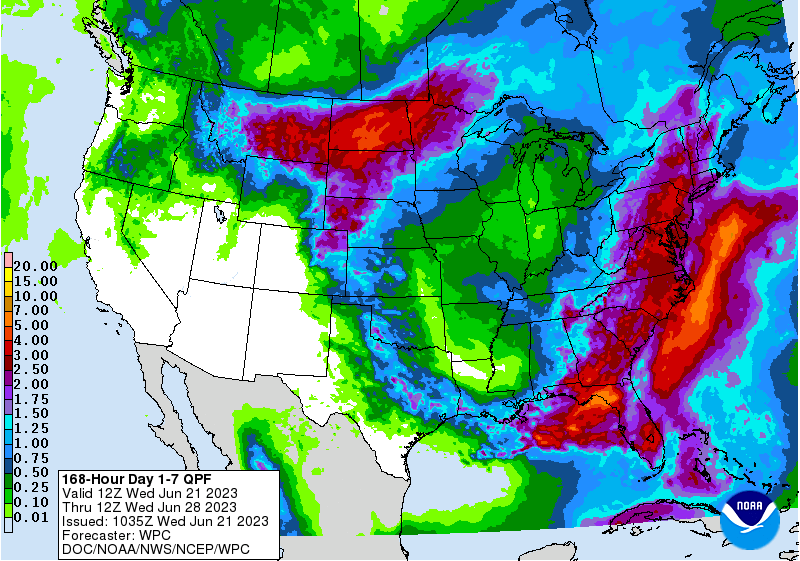
WEATHER
TO WATCH
- U.S.
Midwest drier areas have a good chance for scattered showers and thunderstorms during the late weekend and again in the second half of next week - Resulting
rainfall will be quite varied from one location to the next, but some of the driest areas in Illinois, Iowa, Missouri, Indiana, Wisconsin and Michigan will have an opportunity for some badly needed moisture - No
drought busting rain is expected, but enough moisture will fall in “portions” of the dry region to allow “partial” relief to the poor pollination conditions
- Follow
up rain will be imperative both in higher volume and higher frequency - U.S.
southeastern states will continue to deal with excessive moisture, although a brief break from the pattern is expected this weekend into early next week - Rain
will fall into Friday and again late next week - Southern
Georgia, northern Florida and areas west into southern Mississippi have been most impacted by heavy rain recently
- Crops
in Georgia and the Carolinas will be wettest through Friday while drying occurs in the Delta and interior southeastern crop areas - These
areas will trend wetter again along with Alabama next in the first week of July after a few days of drying this weekend and early next week - U.S.
temperatures are unlikely to be excessively warm in the Midwest, northern Plains, or southeastern states, but excessive heat will impact Texas periodically - Hot
temperatures in Texas Tuesday sent afternoon readings into the range of 100 to 115 degrees Fahrenheit and similar temperatures are expected for at least the next ten days and probably for two weeks - Crop
and livestock stress is already rising and will continue high through the forecast period - Unirrigated
crops will suffer most from the heat and dryness - West
Texas cotton, corn and sorghum conditions will steadily decline over the next two weeks as soil moisture is depleted - Southwestern
dryland areas will be most impacted initially - It
will take a while for the Texas Panhandle, southwestern Oklahoma and the northeastern Counties of West Texas to experience crop moisture stress - Northern
U.S. Plains and Manitoba Canada along with parts of Minnesota will get dryness easing rainfall in this coming week
- Rainfall
of 1.00 to 2.00 inches and locally more will result which should help bolster soil moisture for improved crop development - Sugarbeets,
dry beans, corn, soybeans, sunseed, wheat, barley and oats will all benefit from the moisture along with canola and many other crops - Soil
moisture in these areas is very short in the top and subsoil - U.S.
hard red winter wheat rainfall should become less frequent and less significant for a while which may help to improve crop maturation and harvest conditions in time - Cool
temperatures occurred again in the Pacific Northwest today with frost noted in several areas from eastern Oregon into the upper Snake River Basin, but little to no damage resulted - Mexico’s
drought will last another week to ten days - There
is evidence of developing monsoonal rainfall in the second week of the forecast - Central
America rainfall has been timely recently and mostly good for crops, although many areas are still reporting lighter than usual - Drought
continues to impact Gatlin lake and the Panama Canal shipments with little change likely in future weeks/months - Tropical
Storm Bret was 505 miles east of the Windward islands at 1200 GMT today moving westerly at 16 mph and producing maximum sustained wind speeds of 60 mph out 60 miles from the storm center - Bret
will move across the Lesser Antilles late Thursday and will begin to weaken in the Caribbean Sea during the latter part of this week and into the weekend - The
storm may not survive the wind shear expected over the Caribbean Sea with remnants of the storm eventually drifting into northern parts of Central America next week - A
new tropical depression may form well to the southwest of the Cabo Verde Islands later this week, but it will not be any more significant than Tropical Storm Bret and it may curve to the northeast of the northern Leeward Islands and dissipate without threatening
land next week. - Canada’s
Prairies will receive erratic rainfall in the coming week, but it looks as though southeastern Manitoba may get some significant rain to ease recent dryness - Greater
rain is expected in the Prairies during July to further improve the moisture profile - Northern
Europe is expected to trend over the next few days finally easing some persistent dryness that has lasted more than a month in some areas of Germany, Netherlands, Belgium, eastern France and western Poland - The
lack of hot weather helped conserve soil moisture and protect crop development for much of that period of time - Widespread
rain is expected in Russia’s eastern New Lands and neighboring areas of northern Kazakhstan in the second week of the outlook - Temperatures
will be cooler than usual this week. - Russia’s
northeastern New Lands have been were cool enough for frost and a few light freezes recently, but the impact on crops was minimal.
- India’s
monsoon is expected to begin performing better later this week and especially next week with greater rainfall - Monsoonal
precipitation was virtually non-existent during the weekend as it has been during much of the past three weeks - The
improvement will be greatest from the upper east coast through Madhya Pradesh and Uttar Pradesh to northern parts of the nation - Maharashtra
to Tamil Nadu and Andhra Pradesh will do poorly with rain threatening sugarcane and rice - Recent
rain was greatest from Gujarat and southeastern Sindh, Pakistan into Rajasthan where 2.25 to more than 6.00 inches of rain resulted - The
rain was associated with remnants of Tropical Cyclone Biparjoy - Most
of the greatest rain fell in Gujarat and Rajasthan last weekend and only light to moderate rain has occurred since then into Uttar Pradesh and northern Madhya Pradesh - Some
welcome rain fell in eastern Thailand, Laos and central Vietnam last weekend with rainfall of 1.50 to more than 4.00 inches resulting - Tuesday’s
weather was drier with only sporadic showers of limited significance - Western
Thailand continues to miss the greater rain events, although some showers are occurring periodically - Western
Thailand rice, sugarcane and corn (among other crops) are hurting in the absence of significant rainfall this season - Indonesia
and Malaysia rainfall decreased notably Tuesday with net drying likely in many areas - An
erratic rain pattern is expected for a while - Philippines
rainfall recently has been erratic and mostly light, but soil moisture was rated well.
- Vietnam
coffee, sugarcane and rice production areas in the Central Highlands need greater rain in unirrigated areas - Australia
rainfall recently was greatest in the south - Winter
crop establishment is advancing well. - Timely
rainfall is expected over the next ten days in most crop areas maintaining a well-established crop - South
Africa winter crops are still establishing well and timely rainfall is expected through the next ten days - West-central
Africa crop conditions remain good with little change expected - Rain
will fall in a timely manner during the next two weeks - East-central
Africa weather will continue favorable for coffee, cocoa, sugarcane, rice and other crops through the next two weeks - Ontario
and Quebec weather should be favorably mixed over the next ten days - Summer
crop conditions are still rated favorably with little change likely -
No
changes in South America weather are expected over the coming week -
Argentina
rainfall will be limited leaving many areas from Cordoba into La Pampa and western Buenos Aires too dry for wheat emergence and establishment -
Favorable
field conditions will prevail in the eastern Argentina wheat areas due to previous rain and cool temperatures conserving the moisture through low evaporation rates -
Rain
is possible next week -
Southern
Brazil will continue plenty wet from southern Mato Grosso do Sul to northern and eastern Rio Grande do Sul and Parana over the next ten days -
More
limited rain is expected in center south crop areas while the north is left mostly dry
-
There
is a very low risk of crop damaging cold for the next ten days in any grain, cotton, sugarcane, citrus or coffee area -
China’s
northern Yellow River Basin and neighboring areas of Inner Mongolia are trending drier and this pattern will prevail for a while possibly leading to crop moisture stress for wheat, coarse grains and oilseeds later this summer -
Southern
China will remain plenty wet and may become excessively wet soon -
This
will interfere with early rice maturation and harvesting with some crop quality declines possible -
Some
sugarcane areas will eventually be flooded -
Most
of the greatest rain will be south of rapeseed areas; though much of the rapeseed harvest has likely been completed -
Xinjiang,
China will experience seasonable temperatures over the next two weeks -
Crop
conditions are improving because of the recent development of more seasonable temperatures -
Today’s
Southern Oscillation Index was -12.87 and it will move lower over the next several days
Source:
World Weather, INC.
Wednesday,
June 21:
- Grain
and Oilseeds MENA conference in Cairo, day 1 - SIIA
Haze Outlook 2023 in Singapore - USDA
Total Milk Production
Thursday,
June 22:
- Port
of Rouen data on French grain exports - EIA
weekly US ethanol inventories, production, 10:30am - Grain
and Oilseeds MENA conference in Cairo, day 2 - Brazil
Unica cane crush, sugar production (tentative) - USDA
Red Meat Production, 3pm - HOLIDAY:
China,
Hong Kong
Friday,
June 23:
- USDA
weekly net-export sales for corn, soybeans, wheat, cotton, pork and beef, 8:30am - ICE
Futures Europe weekly commitments of traders report - CFTC
commitments of traders weekly report on positions for various US futures and options, 3:30pm - FranceAgriMer’s
weekly crop condition report - US
Cattle on Feed, 3pm - US
cold storage data for beef, pork and poultry - HOLIDAY:
China
Canada
plantings. June 28 release (7:30 am CDT)
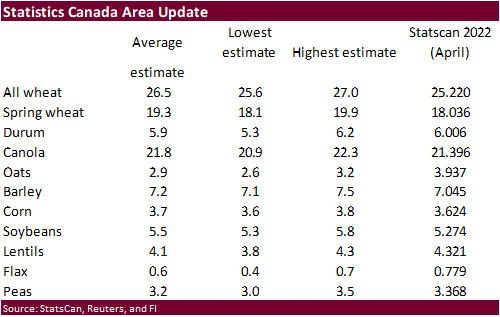
Macros
106
Counterparties Take $2.037 Tln At Fed Reverse Repo Op.
Fed’s
Powell Repeats Officials See Rates Somewhat Higher By Year End
Fed’s
Powell: Process Of Getting Inflation Back Down To 2% Has A Long Way To Go – Prepared Testimony To House Financial Services Committee
Fed’s
Powell: Interest-Rate Pause Is Expected To Be Temporary
Canadian
Retail Sales (M/M) Apr: 1.1% (est 0.4%; prevR -1.5%)
Canadian
Retail Sales Ex Auto (M/M) Apr: 1.3% (est 0.5%; prev -0.4%)
·
A large 6 point drop in US corn crop conditions for the G/E categories sent nearby and new-crop corn futures higher today.
·
December corn traded as high as $6.2950, not seen for that contract since early November.
·
Attached are updated US soybean and corn balance sheets.
·
The USDA Broiler report showed eggs set in the US up slightly from a year ago and chicks placed down slightly.
·
A Bloomberg poll looks for weekly US ethanol production to be up 5,000 thousand barrels to 1028k (1002-1035 range) from the previous week and stocks off 92,000 barrels to 22.134 million.
·
The hardest hit areas for US corn conditions occurred across the ECB followed by the WCB.
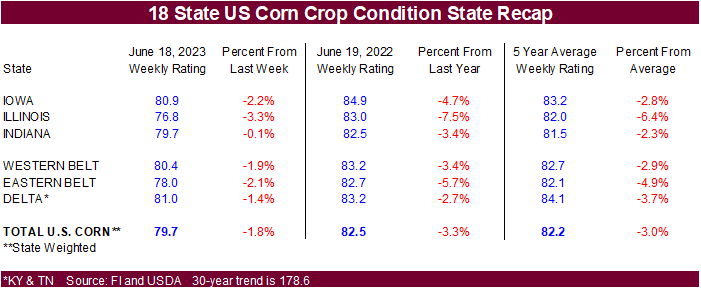
Due
out Friday

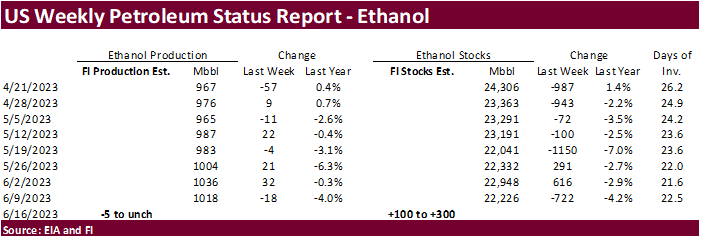
Export
developments.
-
Algeria
seeks 120,000 tons of corn on June 22 for shipment during July shipment and potentially another for FH August shipment.
-
Taiwan’s
MFIG group bought about 65,000 tons of corn from Brazil at 82.79 cents a bushel over the December contract.
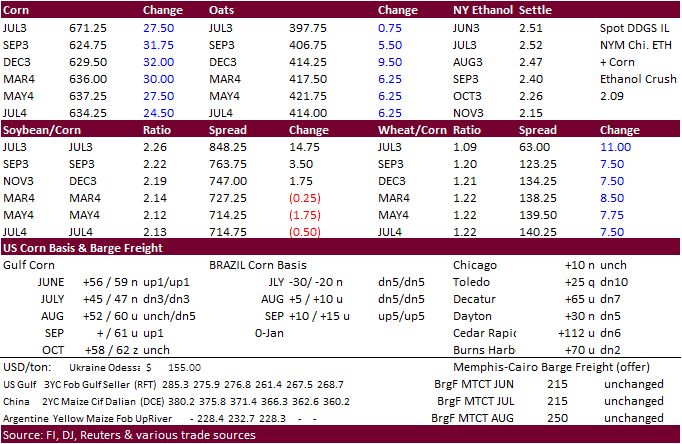
Price
outlook (6/21/23)
July
corn $6.25-$7.25
September
corn $5.75-$7.25
December
corn $5.25-$7.25
·
EPA released mandates for 2023-2025 and traders viewed the advanced biofuel as less than expected, sending soybean oil limit lower (renewable).
·
July soybean oil synthetic was around 55.25. Futures closed at 55.63.
·
Soybeans and meal rallied after USDA released a bullish crop progress report, along with strength in corn and wheat. Crush margins were hammered but soon to expiring July did rebound from session lows. Back month crush margins
still look attractive.
·
September soybean oil prices are expected to stabilize quickly, unlike the follow through selling we saw in December post EPA proposal release. This is based on deteriorating US crop conditions and today’s trade nearly taking
out the speculative gains late last week after EPA announced the delaying RFS mandate release. A lower trend for SBO would theoretically work against the longer term outlook for a ramp up in biofuel production (renewable).
·
We lowered our US soybean yield from 51.5 to 50.4 bu/acre, production from 4.465 to 4.370 billion, exports from 1.960 billion to 1.940 billion, crush unchanged, and carryout out stocks from 315 to 240 million.
·
We heard last week that China bought about 34 cargoes of soybeans from Brazil and 4 out of the PNW. Some speculate the PNW cargoes are for new crop for stockpiling.
·
US soybean conditions dropped 5 points from the previous week. Still early but worrisome.
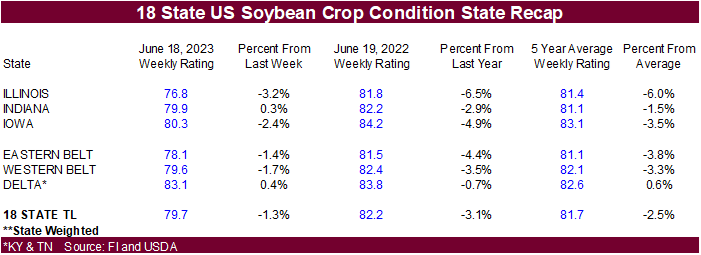
·
(Bloomberg) — India’s oilmeals exports fell to 436,596 tons in May from 493,448 tons in April, according to the Solvent Extractors’ Association of India.
-
Rapeseed
meal exports fell to 233,663 tons from 246,568 tons in April -
Soymeal
exports fell to 114,225 tons from 177,243 tons in April -
Rice-bran
extract exports rose to 42,398 tons from 37,479 tons in April
-
China
will auction off 306,700 tons of imported soybeans from state reserves on June 27.
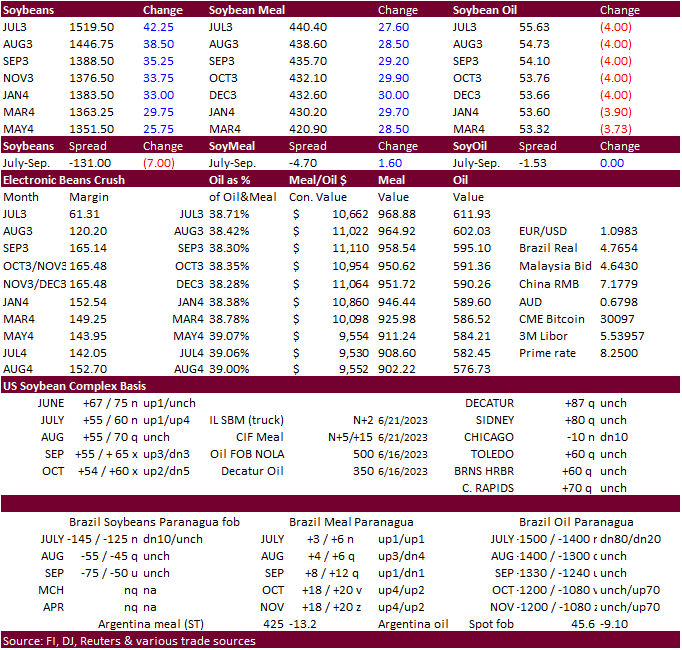
Price
outlook (6/21/23)
Soybeans
– July $14.50-$15.50, November $12.50-$15.25
Soybean
meal – July $400-$475, December $375-$500
Soybean
oil – July 51.00-58.00, December 50.00-58.00
·
US wheat traded higher from a steep drop in the US spring wheat rating and higher corn. US winter wheat conditions were unchanged, about as expected.
·
September Paris wheat futures were up 7.00 euros at 247 per ton.
·
An India trade group told Reuters that they look for the wheat crop to fall short of government expectations to around 101 and 103 million tons, below the official 112.74 million tons estimated by the government. USDA is at 113.5
million tons.
·
SovEcon estimated Russia wheat production at 86.8 million tons, down from 88 million previous. USDA this month raised their estimate to 85MMT from previous 81.5 and compares to 2022-23 of 92 MMT.
·
Germany’s association of farm cooperatives estimated 2023 wheat crop to decrease 2.9% to 21.87 million tons. Winter rapeseed was seen down 3.1% to 4.14 million tons.
·
China is nearing winter wheat harvest completion. 137MMT was last projected by the country. USDA is at 140MMT.
Export
Developments.
·
Japan seeks 92,529 tons of milling wheat later this week for Aug shipment.
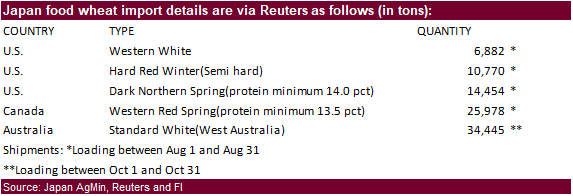
Rice/Other
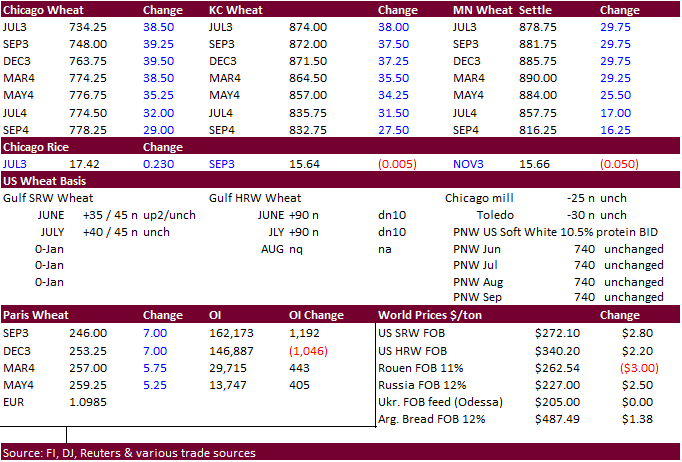
Price
outlook (6/21/23)
Chicago
Wheat July $7.00-$7.75, September $7.00-$8.25
KC – July $8.25-$9.10, September $8.00-$9.50
MN – July $8.25-$9.25, September $8.00-$9.50
#non-promo
